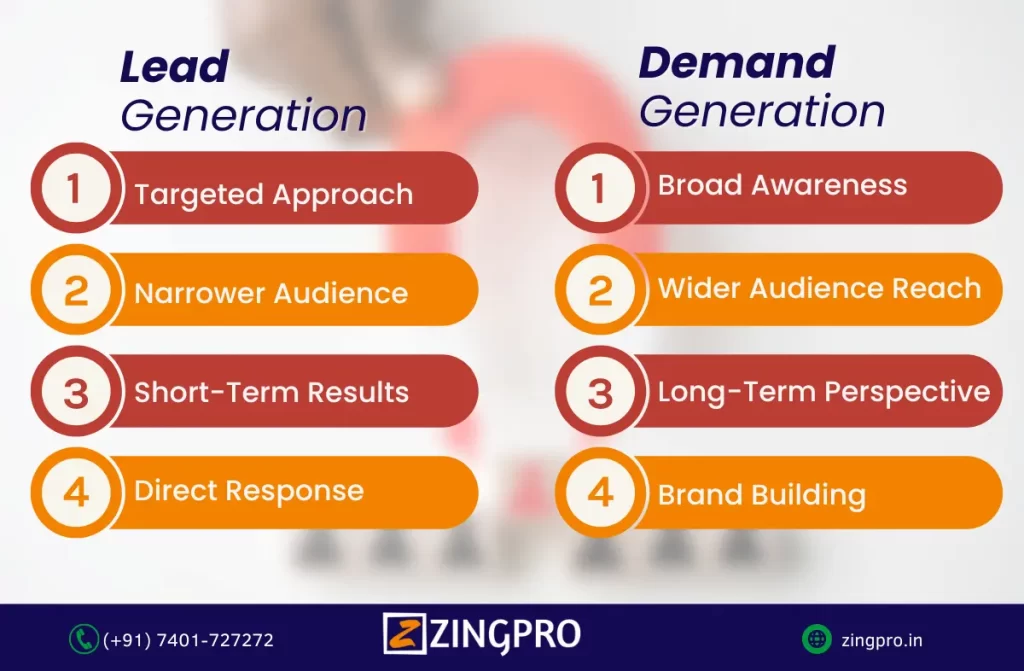As a marketer, you’re likely familiar with the terms “lead generation” and “demand generation.” But do you know the key differences between these two approaches, and how they can impact your overall marketing strategy? In this post, we’ll explore the definition, goals, strategies, timing, metrics, and ROI associated with lead generation and demand generation. And also get to know about Lead Generation vs. Demand Generation: What’s the Difference?
Definition and Key Goals
At its core, lead generation is all about identifying potential customers and gathering their contact information. This might involve creating lead magnets, running paid ads, or sending out email campaigns, all with the goal of encouraging people to share their name, email address, or other relevant information.
The ultimate goal of lead generation is to build up a list of leads that your sales team can reach out to and try to convert into customers
On the other hand, demand generation is more focused on creating interest in your brand and products or services. This might involve things like creating helpful blog posts, running social media campaigns, or partnering with influencers to spread the word about your offerings.
The ultimate goal of demand generation is to build awareness and interest in your brand, which can then translate into leads and eventually sales.
Here in this above description clearly mentioned Lead Generation vs Demand Generation: With their key goals and perspective.
Lead Generation vs. Demand Generation
Lead Generation vs. Demand Generation is two different marketing approaches that are often used by businesses to generate more revenue and grow their customer base.
Lead Generation
Lead generation is the method of relocating potential customers and accumulating their contact information. The goal of lead generation is to create a list of potential customers that your sales team can then reach out to and try to convert into paying customers.
Demand Generation
Demand generation is the process of creating interest and awareness in your brand and products or services. The goal of demand generation is to build a relationship with potential customers, educate them on the benefits of your offerings, and create a sense of urgency that leads them to take action.
In the above two statements clearly brief you about Lead Generation vs Demand Generation.

Strategies and Tactics
The strategies and tactics associated with lead generation and demand generation can differ significantly. For example, lead generation might involve creating a free ebook, whitepaper, or webinar that people can access in exchange for their contact information. Or, you might use paid ads to target people who are likely to be interested in your products or services and encourage them to submit their contact information.
Demand generation, on the other hand, might involve creating high-quality blog posts or videos that showcase your expertise and provide value to potential customers. You might use social media to engage with your audience and build relationships, or partner with influencers who can help spread the word about your brand.
The goal is to create interest in your brand and products, even among people who might not be ready to become leads just yet.
When you are searching for effective tips and strategies for Lead Generation vs Demand Generation, here above you can get to know them perfectly.
Timing and Lifecycle
Another way to think about the difference between lead generation and demand generation is to consider where they fit into the overall marketing lifecycle. Lead generation tends to come earlier in the process when you’re still trying to build awareness and gather leads.
Demand generation, on the other hand, is often more focused on nurturing those leads and turning them into actual customers.
In other words, lead generation is the “top of the funnel” stuff, while demand generation is more “middle of the funnel.”
Metrics and ROI
Finally, it’s important to consider how lead generation and demand generation differ in terms of the metrics you use to measure success, and how they ultimately impact your bottom line. Lead generation might be more focused on metrics like cost per lead, conversion rates, or the number of leads generated.
Demand generation might look more at metrics like website traffic, bounce rate, time on site, brand awareness, or customer lifetime value. The goal is ultimately to generate more revenue for your business, but the path to getting there can differ depending on whether you’re focusing on lead generation or demand generation.
What are lead generation and demand Generations?
Lead Generation vs Demand Generation is two different marketing approaches that businesses can use to attract and convert potential customers. While the two approaches are related, there are some key differences between them.
Lead generation is the steps to finding the potential customers and assembling their contact information. Whereas demand generation is the process of creating interest and awareness in your brand and products or services.
What are the goal of demand generation and lead generation?
Lead Generation vs Demand Generation both goals are different: –
The goal of lead generation is to create a list of potential customers that your sales team can then reach out to and try to convert into paying customers.
The goal of demand generation is to build a relationship with potential customers, educate them on the benefits of your offerings, and create a sense of urgency that leads them to take action.
What are qualified lead generation and demand generations?
Qualified Lead Generation vs Demand Generation is a marketing approach that focuses on attracting and engaging potential customers who are most likely to be interested in a company’s products or services.
Qualified lead generation involves identifying potential customers who have expressed a specific interest in a company’s offerings, while demand generation focuses on creating a general interest in a company’s brand and offerings.
Conclusion
In conclusion, the difference between lead generation and demand generation are two distinct but complementary approaches to marketing. Lead generation is focused on identifying potential customers and gathering their contact information, while demand generation is focused on creating interest in your brand and products or services.
By understanding the differences between these two approaches and how they fit into your overall marketing strategy, you can develop a more effective and impactful plan for growing your business.
Check out Online Lead Generation company in India.


